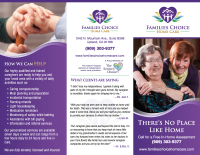
Once you notice signs a parent or aging loved one needs support, you may consider in-home care vs. assisted living as part of your solution. It’s important to note there are pros and cons to each option.
First and foremost, we believe the client’s wishes and desires should be at the center of the discussion. It’s not always easy starting conversations about life changes and changes in daily living. Your loved one may even refuse care. However, compassionate discussions form a foundation for solutions that honor a person’s integrity and dignity while putting the right care systems in place.
In-Home Care vs. Assisted Living: Questions to Consider
Conversations and decision-making can lead to multiple tangents and offshoots, making it hard to land on a final answer that feels right to everyone involved. To keep discussions productive, we recommend focusing on these five overarching considerations.
1. What does your loved one want?
Your loved one’s preferences should always be honored and placed above all other considerations. Does that mean the family can give them what they want? Not necessarily. But they deserve to feel you’re doing your best to accommodate their desires or to create the “next best option” for them.
Keep in mind:
- 90% of adults 65+ want to stay in their homes as they age (AARP).
- There are affordable and no-cost ways to make a home safe and accessible to meet the ever-changing needs of aging adults.
- Most licensed home care agencies offer memory care that meets or exceeds residential memory care facility offerings so be sure to ask questions before hiring a caregiver.
- Community engagement and social connections are typically more sustainable when clients age in place, improving overall well-being and quality of life.
- Those who age in place with sufficient support are less likely to feel lonely, anxious, depressed, or hopeless (Science Daily).
There is a time and place for facility- or community-based residential care, but it’s never the only option. Remember to keep an open mind and prioritize your loved one’s preferences.
2. How much does private home care cost per hour?
We know your loved one’s health and overall well-being are the number one priority. However, finances are the elephant in the room, and we believe money should never become the reason for a second-choice decision.
According to Genworth’s Cost of Long-Term Care estimates, the hourly rate for in-home caregivers in Riverside and the Surrounding Inland Empire is $32. That assumes you’re hiring an experienced, professional caregiver from a licensed agency.
The hourly cost for in-home senior care from an agency may be higher than “private” caregiving rates you see online for independent caregivers. Therefore, it’s essential to understand that agency-based wages are higher for a reason. Agency employees are:
- Vetted by clear criminal background checks, clear health screenings, and a clean DMV record
- Fairly paid
- Get paid time off (PTO) and holidays (filled by other caregivers, so there’s never a missed shift)
- Offered PTO for personal/family sick days
- Covered by health insurance
- Given a 401(k) or similar retirement savings plan
Also, when hiring from a licensed home care agency, you never have to worry about a no-show or a last-minute cancellation. Our caregivers work in rotating teams, so there’s always someone to fill in the inevitable gaps.
Before the money question triggers the panic button, ensure you’ve identified the many ways you can pay for long-term senior care. Examples include:
- Untapped savings
- Unused retirement funds
- Investments
- Life insurance policies
- Medicare benefits
- V.A. benefits
- Private health insurance (that may pay for specific, short-term in-home care or home health services)
- Reverse mortgage options
Meet with a fee-based financial advisor specializing in long-term care to learn more about the options. You may discover more funds to draw from than you originally anticipated.
3. What’s the average monthly cost for assisted living
Assisted living communities provide monthly costs at a “baseline.” Be very discerning when reviewing their financial literature. Unlike in-home care wages, paid by the hour regardless of which services you implement, assisted living facilities charge extra for any number of services beyond the “room and board” basics.
For example, while the average baseline cost for assisted living in the Inland Empire is $4000 (nursing homes are $8,865 for a private room), residents are typically billed extra for:
- Laundry
- Extra utilities
- Meals brought to rooms
- Medication reminders
- Mobility support
- Transportation services
- Outings and field trips
- Toileting or incontinence care
- Help with personal and hygiene care
- And more
As the needs of the residents increase, so do the monthly fees. In many cases, total monthly bills are 50% greater (or more) than the initially budgeted price.
4. Will social engagement increase or decrease with a move?
Diet and exercise are certainly a priority for physical health and well-being, but social engagement is equally important. Study after study points to a direct correlation between social engagement and senior well-being.
According to a recent study posted on BMC Health, seniors who don’t get enough community engagement and social connection may experience:
- Prolonged sitting time
- Unhealthy sleep duration
- Perceived depression
- Poor self-rated health
- Low quality of life
Because assisted living facilities have so many residents, it’s easy for depressed or lonely seniors to become increasingly isolated. They can retreat into their private rooms. This is a typical response for residents without access to their regular friend network, social engagements, or religious/spiritual community.
Seniors in assisted living facilities no longer have the ability to maintain relationships with familiar grocery store employees, favorite barbers/hairdressers, etc. These social losses take a toll.
On the flip side, in-home care means clients have the same access (or more) to their community and neighborhoods, including favorite people, places, and things via transportation services and routine engagement with their team of caregivers/companions.
5. Does your loved one have dementia, Alzheimer’s, or another progressive disease?
Long-term planning means precisely that. You must identify where your loved one is now and consider the potential for age-related decline and memory loss that comes with progressive diseases. In-home care means a single price for all services whereas assisted living may mean fluctuating prices that increase with residents’ needs.
Read More: In-Home Care Benefits for Seniors
Choosing the Best In-Home Services for Your Loved One
Before you make up your mind about in-home care vs. assisted living, you can schedule a free assessment to gain expert insight into what options are available to you now and in the future.
Families Choice Home Care is happy to meet with you and your loved one to get a better idea of your needs and to determine which options make the most sense for your family. Click below to learn more about private in-home care services.





